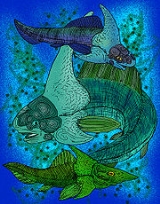
Weejasperaspididae
Encyclopedia
Weejasperaspididae is a family of three extinct acanthothoracid placoderm species
indigenous to the Early Devonian
"Taemas-Wee Jasper" reef off the southeastern coast of Gondwanaland, located near what is now the town of Wee Jasper, in New South Wales
, Australia
.
The placoderm Brindabellaspis stensioi was once regarded as a weejasperaspid because of the similarities between its armor and dermal plates to the other weejasperaspids. Even before it was split off into its own order, it stood out from the others because of its long, pointed snout. French paleontologist Phillipe Janvier placed B. stensioi in its own order, Brindabellaspida, because of how the internal anatomy of the braincase resembled more like those of osteostracans
or galeaspids than those of other placoderms.
Species
In biology, a species is one of the basic units of biological classification and a taxonomic rank. A species is often defined as a group of organisms capable of interbreeding and producing fertile offspring. While in many cases this definition is adequate, more precise or differing measures are...
indigenous to the Early Devonian
Devonian
The Devonian is a geologic period and system of the Paleozoic Era spanning from the end of the Silurian Period, about 416.0 ± 2.8 Mya , to the beginning of the Carboniferous Period, about 359.2 ± 2.5 Mya...
"Taemas-Wee Jasper" reef off the southeastern coast of Gondwanaland, located near what is now the town of Wee Jasper, in New South Wales
New South Wales
New South Wales is a state of :Australia, located in the east of the country. It is bordered by Queensland, Victoria and South Australia to the north, south and west respectively. To the east, the state is bordered by the Tasman Sea, which forms part of the Pacific Ocean. New South Wales...
, Australia
Australia
Australia , officially the Commonwealth of Australia, is a country in the Southern Hemisphere comprising the mainland of the Australian continent, the island of Tasmania, and numerous smaller islands in the Indian and Pacific Oceans. It is the world's sixth-largest country by total area...
.
Description
As with other acanthothoracids, the weejasperaspids were heavily armored, with a pair of spines that emanated from their chests, and had a large spine emanating from the top of their backs. They had blunt snouts, and are suspected of being shellfish eaters.Evolutionary Relationships
The main reasons why the weejasperaspids are not considered to be closely related to other non-acanthothoracid placoderms, as opposed to the palaeacanthaspids, are that their skull anatomies and plate histologies are generalized, and do not bear any similarities to any specific non-acanthothoracid group, and that the patterns of ornamentation on their dermal plates are unique to this family.The placoderm Brindabellaspis stensioi was once regarded as a weejasperaspid because of the similarities between its armor and dermal plates to the other weejasperaspids. Even before it was split off into its own order, it stood out from the others because of its long, pointed snout. French paleontologist Phillipe Janvier placed B. stensioi in its own order, Brindabellaspida, because of how the internal anatomy of the braincase resembled more like those of osteostracans
Osteostraci
The class Osteostraci was a group of bony-armored jawless fish, termed "ostracoderms", that lived in what is now North America, Europe and Russia from the Middle Silurian to Late Devonian....
or galeaspids than those of other placoderms.

